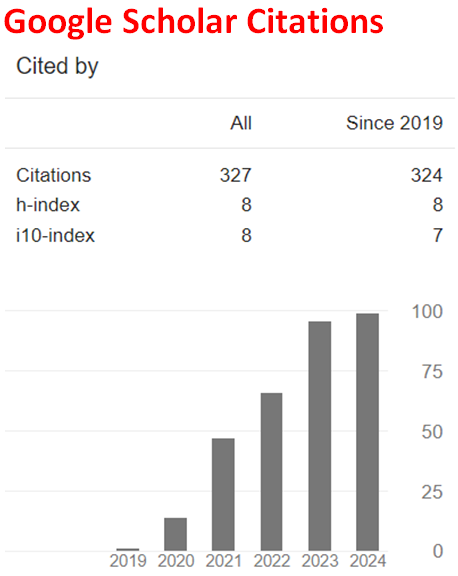Some Novel Tricyclic Caged-Nitramines - A DFT Study
Abstract
A tricyclic caged-nitramine structure having embedded RDX base has been designed. It also has three etheric linkages in the cage structure. In that sense it reminds TEX structure but it has much better oxygen balance than RDX and TEX. Then two hetero atom exchange operation (N to O replacement) at a time has been carried out to produce different isomeric structures. Through optimization process (B3LYP/6-311++G(d,p)) they have yielded some conformers and stereoisomers. The effect of heteroatom replacement on various geometrical, quantum chemical and spectral properties of the isomers have been investigated and discussed.
Downloads
References
T.P. Parr and D.M. Hanson-Parr, Optical diagnostics of solid propellant flame structure, in: Solid Propellant Chemistry, Combustion, and Motor Interior Ballistics, V. Yang, T. B. Brill, and W. Z. Ren, eds., Vol. 185, Progress in Astronautics and Aeronautics, AIAA, Reston, VA, 2000, pp. 381-411. https://doi.org/10.2514/5.9781600866562.0381.0411
O.P. Korobeinichev, Flame structure of solid propellants, in: Solid Propellant Chemistry, Combustion, and Motor Interior Ballistics, V. Yang, T. B. Brill, and W. Z. Ren, eds., Vol. 185, Progress in Astronautics and Aeronautics, AIAA, Reston, VA, 2000, pp. 335-354. https://doi.org/10.2514/5.9781600866562.0335.0354
T.A. Litzinger, Y.-J. Lee and C.-J. Tang, Experimental studies of nitramine/azide propellant combustion, in: Solid Propellant Chemistry, Combustion, and Motor Interior Ballistics, V. Yang, T. B. Brill, and W. Z. Ren, eds., Vol. 185, Progress in Astronautics and Aeronautics, AIAA, Reston, VA, 2000, pp. 355-379. https://doi.org/10.2514/5.9781600866562.0355.0379
C.F. Melius, Thermochemical modeling: I. Application to decomposition of energetic materials, in: Chemistry and Physics of Energetic Materials, S. Bulusu, ed., Norwell, MA: Kluwer Academic, 1990, pp. 21-78.
Y.-C. Liau and V.J. Yang, Analysis of RDX monopropellant combustion with two-phase subsurface reactions, Prop. Power 11 (1995), 727-739. https://doi.org/10.2514/3.23898
J.E. Davidson and M.W. Beckstead, Twenty-Sixth Symposium (International) on Combustion, The Combustion Institute, Pittsburgh, 1996, pp. 1989-1996.
J.E. Davidson and M.W. Beckstead, Modeling of HMX/GAP pseudo-propellant combustion, J. Prop. Power 13 (1997), 375-383.
K. Prasad, R.A. Yetter and M. Smooke, An eigenvalue method for computing the burning rates of RDX, Propellants Combust. Sci. Technol. 124 (1997), 35-82.
K. Prasad, R.A. Yetter and M. Smooke, An eigenvalue method for computing the burning rates of HMX propellants, Combust. Flame 115 (1998), 406-416. https://doi.org/10.1016/S0010-2180(98)00009-1
J.L. Gottfried, Laser-induced plasma chemistry of the explosive RDX with various metallic nanoparticles, Appl. Opt. 51 (2012), B13-B21. https://doi.org/10.1364/AO.51.000B13
Y.-C. Liau, E.S. Kim and V. Yang, A comprehensive analysis of laser-induced ignition of RDX monopropellant, Combustion and Flame 126 (3) (2001), 1680-1698. https://doi.org/10.1016/S0010-2180(01)00281-4
L. Qiu, X. Gong, X. Ju and H. Xiao, Substituent effect on the molecular stability, group interaction, detonation performance, and thermolysis mechanism of nitroamino- substituted cyclopentanes and cyclohexanes, Science in China, Series B: Chemistry 51(12) (2008), 1231-1245. https://doi.org/10.1007/s11426-008-0141-1
J. Yang, G. Wang, X. Gong, J. Zhang and Y.A. Wang, High-energy nitramine explosives: A design strategy from linear to cyclic to caged molecules, ACS Omega 3(8) (2018), 9739-9745. https://doi.org/10.1021/acsomega.8b00614
C.A. Bayse and M. Jaffar, Bonding analysis of the effect of strain on trigger bonds in organic-cage energetic materials, Theoretical Chemistry Accounts 139(6) (2020), Art. No. 95. https://doi.org/10.1007/s00214-020-02604-0
L. Türker, Hexahydro-1,3,5-trinitro-1,3,5-triazine-embedded cyclophanes, Journal of Molecular Structure: THEOCHEM. 530 (1-2) (2000), 131-136. https://doi.org/10.1016/S0166-1280(00)00320-1
L. Türker, On the possibility of endohedrally helium-doped TEX – A DFT treatment, ZAAC 644(18) (2018), 1096-1102. https://doi.org/10.1002/zaac.201800183
L. Türker, Destructive effect of magnesium and calcium atoms on TEX, Defence Technology 13(5) (2017), 367-375. https://doi.org/10.1016/j.dt.2017.02.001
L. Türker and S. Variş, On the possibility of autoxidation of TEX - A DFT study, Propellants, Explosives, Pyrotechnics 40(1) (2015), 81-87. https://doi.org/10.1002/prep.201400114
L. Türker, Nitrogen analogs of TEX – A computational study, Defence Technology 10(4) (2014), 328-333. https://doi.org/10.1016/j.dt.2014.07.001
Y. Bayat and V. Azizkhani, Synthesis of 4,10-dinitro-2,6,8,12-tetraoxa-4,10- diazaisowurtzitane (TEX) using heteropolyacids as efficient and recyclable heterogeneous catalysts, Journal of Energetic Materials 30(3) (2012), 209-219. https://doi.org/10.1080/07370652.2011.562600
U.R. Nair, R. Sivabalan, G.M. Gore, M. Geetha, S.N. Asthana and H. Singh, Hexanitrohexaazaisowurtzitane (CL-20) and CL-20-based formulations (review), Combustion, Explosion and Shock Waves 41 (2005), 121-132. https://doi.org/10.1007/s10573-005-0014-2
L. Bao, P. Lv, T. Fei, Y. Liu, C. Sun and S. Pang, Crystal structure and explosive performance of a new CL-20/benzaldehyde cocrystal, Journal of Molecular Structure 1215 (2020), 128267. https://doi.org/10.1016/j.molstruc.2020.128267
J.J.P. Stewart, Optimization of parameters for semiempirical methods I. Method, J. Comput. Chem. 10 (1989), 209-220. https://doi.org/10.1002/jcc.540100208
J.J.P. Stewart, Optimization of parameters for semi empirical methods II. Application, J. Comput. Chem. 10 (1989), 221-264. https://doi.org/10.1002/jcc.540100209
A.R. Leach, Molecular Modeling, Essex: Longman, 1997.
P. Fletcher, Practical Methods of Optimization, New York: Wiley, 1990.
W. Kohn and L. Sham, Self-consistent equations including exchange and correlation effects, Phys. Rev. 140 (1965), 1133-1138. https://doi.org/10.1103/PhysRev.140.A1133
R.G. Parr and W. Yang, Density Functional Theory of Atoms and Molecules, London: Oxford University Press, 1989.
C.J. Cramer, Essentials of Computational Chemistry, Chichester, West Sussex: Wiley, 2004.
A.D. Becke, Density-functional exchange-energy approximation with correct asymptotic behavior, Phys. Rev. A 38 (1988), 3098-3100. https://doi.org/10.1103/PhysRevA.38.3098
S.H. Vosko, L. Wilk and M. Nusair, Accurate spin-dependent electron liquid correlation energies for local spin density calculations: a critical analysis, Can. J. Phys. 58 (1980), 1200-1211. https://doi.org/10.1139/p80-159
C. Lee, W. Yang and R.G. Parr, Development of the Colle-Salvetti correlation-energy formula into a functional of the electron density, Phys. Rev. B 37 (1988), 785-789. https://doi.org/10.1103/PhysRevB.37.785
SPARTAN 06, Wavefunction Inc., Irvine CA, USA, 2006.

This work is licensed under a Creative Commons Attribution 4.0 International License.


